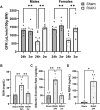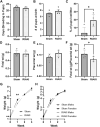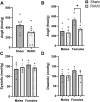Parental recovered acute kidney injury causes prenatal renal dysfunction and fetal growth restriction with sexually dimorphic implications for adult offspring
- PMID: 38681142
- PMCID: PMC11045984
- DOI: 10.3389/fphys.2024.1357932
Parental recovered acute kidney injury causes prenatal renal dysfunction and fetal growth restriction with sexually dimorphic implications for adult offspring
Abstract
Introduction: Acute kidney injury (AKI) is rapidly increasing in global incidence and a healthcare burden. Prior maternal AKI diagnosis correlates with later pregnancy complications. As pregnancy influences developmental programming, we hypothesized that recovered parental AKI results in poor pregnancy outcomes, impaired fetal growth, and adult offspring disease. Methods: Using a well-characterized model of rhabdomyolysis-induced acute kidney injury (RIAKI), a form of AKI commonly observed in young people, we confirmed functional renal recovery by assessing glomerular filtration rate (GFR) 2 weeks following RIAKI. We bred sham and recovered RIAKI sires and dams in timed, matched matings for gestational day (GD) 16.5 and offspring (birth-12 weeks, 6 months) study. Results: Despite a normal GFR pre-pregnancy, recovered RIAKI dams at GD16.5 had impaired renal function, resulting in reduced fetoplacental ratios and offspring survival. Pregnant RIAKI dams also had albuminuria and less renal megalin in the proximal tubule brush border than shams, with renal subcapsular fibrosis and higher diastolic blood pressure. Growth-restricted offspring had a reduced GFR as older adults, with evidence of metabolic inefficiency in male offspring; this correlated with reduced renal AngII levels in female offspring from recovered RIAKI pairings. However, the blood pressures of 6-month-old offspring were unaffected by parental RIAKI. Conclusions: Our mouse model demonstrated a causal relationship among RIAKI, gestational risk, and developmental programming of the adult-onset offspring GFR and metabolic dysregulation despite parental recovery.
Keywords: acute kidney injury; developmental programming; pregnancy; renal function; rhabdomyolysis.
Copyright © 2024 Hebert, Funahashi, Emathinger, Nickerson, Groat, Andeen, Gurley and Hutchens.
Conflict of interest statement
The authors declare that the research was conducted in the absence of any commercial or financial relationships that could be construed as a potential conflict of interest.
Figures





Similar articles
-
Legal Performance-enhancing Drugs Alter Course and Treatment of Rhabdomyolysis-induced Acute Kidney Injury.Mil Med. 2023 Nov 8;188(Suppl 6):346-353. doi: 10.1093/milmed/usad142. Mil Med. 2023. PMID: 37948276 Free PMC article.
-
Role of NLRP3 Inflammasomes for Rhabdomyolysis-induced Acute Kidney Injury.Sci Rep. 2015 Jun 5;5:10901. doi: 10.1038/srep10901. Sci Rep. 2015. PMID: 26045078 Free PMC article.
-
Oxidative stress and inflammasome activation in human rhabdomyolysis-induced acute kidney injury.Free Radic Biol Med. 2020 Nov 20;160:690-695. doi: 10.1016/j.freeradbiomed.2020.09.011. Epub 2020 Sep 14. Free Radic Biol Med. 2020. PMID: 32942024
-
Increased susceptibility to cardiovascular disease in offspring born from dams of advanced maternal age.J Physiol. 2018 Dec;596(23):5807-5821. doi: 10.1113/JP275472. Epub 2018 Jun 21. J Physiol. 2018. PMID: 29882308 Free PMC article.
-
Molecular Mechanisms of Rhabdomyolysis-Induced Kidney Injury: From Bench to Bedside.Kidney Int Rep. 2022 Sep 30;8(1):17-29. doi: 10.1016/j.ekir.2022.09.026. eCollection 2023 Jan. Kidney Int Rep. 2022. PMID: 36644345 Free PMC article. Review.
Cited by
-
Hypertension-induced heart failure disrupts cardiac sympathetic innervation.Am J Physiol Heart Circ Physiol. 2024 Dec 1;327(6):H1544-H1558. doi: 10.1152/ajpheart.00380.2024. Epub 2024 Nov 1. Am J Physiol Heart Circ Physiol. 2024. PMID: 39485300
References
Grants and funding
LinkOut - more resources
Full Text Sources
Research Materials

